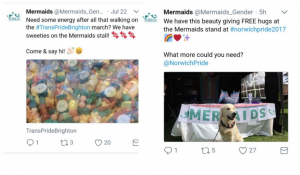

When we hear stories of ‘trans’ children in the media we are usually struck by two things. Firstly, the photo of the cute, vulnerable child- nearly always a long-haired boy in pink and a tutu- and secondly the fierce love and support offered by the parents. To question this narrative seems churlish, even cruel: usually, parents know their children best and this child obviously needs protecting from the harsh realities of modern culture. We may have a fleeting thought that perhaps the child’s best interests may not be being served by parading them all over social media; but we see cute, we see love and we move on, proud that our hearts are so inclusive and that the label ‘transphobic’ does not apply to us. We tell ourselves the story needs to be told; the message needs to be got across. But what exactly is the message?
The message is very simple and very dangerous, especially to young, growing minds. The message is that there is a ‘right’ and a ‘wrong’ way to be a girl or a boy.
In interviews with the parents of ‘trans’ children we hear how the girl liked superheroes and hated dresses, or how the boy loved to dance and sing. With boys, a love of glitter and pink is often viewed as conclusive proof of transgenderism; a desire for short hair and an interest in physical sports is what often ‘proves’ a girl is really a boy. In some cases, parents seemed unhappy with the child’s choice of interests; some spanked the gender non-conforming child, or tried to force it into the conventional role by taking away the toys or clothes that they considered inappropriate. The child’s reticence and growing unhappiness at being dictated to is used as further ‘proof’ of the authenticity of the pink/blue brain argument.
One mother speaks of how she misses the hours spent forcing her daughter’s hair into pretty cornrows and plaits: the fact that her now ‘son’ is so much happier with short hair is proof of the child being born in the wrong body rather than an understandable relief at not having her hair yanked around any more. One eight-year-old boy, the subject of a UK TV documentary, felt that he was expected to ‘choose’ whether to be a boy or a girl. Under first analysis, there seems to be little more foundation than a desire to play games and wear clothes usually associated with the opposite sex, but another, darker, factor to consider is how casual sexism and homophobia affect these children. One mother posted on Twitter of being proud that her child would be able to get married in a church now she is ‘trans’: her religion would have rejected her gay son but embraces her ‘trans’ daughter. One young boy who now ‘lives as a girl’ spoke of how he looked forward to hugging and kissing his future husband. One teenage girl who has had both breasts removed talks about how great it is to be able to go topless on the beach at last.
Any suggestion that the child’s behaviour is a rebellion against society’s gender stereotypes is met with insistence that it is more than that- parents will also say the child insisted they felt like the opposite sex; that they were ‘born in the wrong body’. It seems astonishing that we’re willing to set a child up for a lifetime of beguilement, medication and surgery based on little more than what have been described as ‘the whims of toddlers’.
My friend’s 4 year old niece thought her new fairy wings would actually make her fly. My brother-in-law was absolutely certain, aged six, that if he jumped off the top of the woodpile often enough, he would eventually take off. I was probably six or seven before I stopped believing that my toys came to life at night and talked to each other. Kids believe weird stuff. That’s one of the reasons why they need adults to protect them.
The trans-identifying child likes the toys, clothing and hobbies more often associated with the opposite sex, and this leads to a feeling that they actually ARE the opposite sex. Push further, you hit a wall. The girl likes boy stuff. She ‘feels’ like a boy. The child is distressed; the parents are distressed, it’s an awful situation and it may seem like there’s a quick fix, but that fix is based on a lie. A boy cannot possibly know what it feels like to be a girl. Beyond biological structure, there is no one single experience of being a girl, and while neuroscientists can often make an educated guess, they cannot tell whether a brain is male or female. Outside of the realms of sparkly unicorns, giant alien lizards and those who like a nice cup of mushroom tea at bedtime, it is not possible to be ‘born in the wrong body’, and until recently it was perfectly fine to admit that we all know that. So how have we so very, very quickly reached a point where we are medicating pre-pubescent children, telling them they it is possible to magically ‘change sex’ and removing healthy body parts?
The new idea is that a girl who says she is a boy, or a boy who says he is a girl, should immediately have the idea affirmed and their pronouns changed, and that anyone who says otherwise is transphobic and guilty of supporting conversion therapy. People have lost their jobs for questioning that this might not necessarily be the best route. There’s even an idea going around that children of parents who do not affirm their trans identity should be removed from their homes and placed in state care.
‘Conversion therapy’ really does sound awful, a throw back to the beatings, electric shocks and brainwashing that lesbians and gay men were subjected to mid-20th century. So what exactly is it? We aren’t talking beatings, electric shocks and brainwashing here.
‘Conversion therapy’ is the label currently being given to the idea of trying to help children feel more comfortable in their skin and learn to be happy with the body they have. It seems odd to suggest it isn’t worth giving this a go. After all, we know that historically, around 80% of GNC kids grow up to be lesbian or gay.
We’re talking about listening to a child, discussing their feelings and making sure that a child genuinely understands that hating pink & liking Bob the Builder, or fancying girls and really, really wanting to be the lead singer of 21 Pilots, doesn’t actually mean she IS a boy.
We’re talking about telling a child that he doesn’t have to change his body because of his hobbies or the clothes he likes to wear; that liking sparkles and pink and dancing doesn’t make him any less of a boy. We’re talking about telling a child that she is perfect just as she is and she doesn’t need to change herself to fit society’s notions of what is acceptable gendered behaviour. We’re talking about encouraging the ever-increasing number of teenage girls who hate their changing bodies and want their breasts removed to take it slowly, wait a while before jumping ship; no need to change your name to Aiden, Skyler, Alex or Ryan just yet…
How could anyone possibly think this is a bad idea?

Do you want a live son or a dead daughter?
The attempted suicide rate is high among people who identify as transgender and worried parents and concerned teachers everywhere are being told that a child who is repeatedly misgendered, or not allowed to ‘live as their authentic self’ is likely to kill themselves. The phrase ‘do you want a live son or a dead daughter?’ comes up over and over again. Yet at the same time we are supposed to believe that identifying as transgender is not a sign of mental illness. This demand for ‘doublethink’ is also implicit in the idea that transitioning a child is somehow an act of authenticity, and the idea that a boy who says he is a girl is, literally, a girl.
Our media is awash with the idea that young people who identify as trans will kill themselves- or at very least self harm – if their belief that they are ‘trapped in the wrong body’ is not immediately affirmed by everyone about them. This is irresponsible reporting for several reasons.
The UK government website reports that, “probably the most important influence promoting (suicide) clusters to develop is the spread of news about suicides via the media.”
A US government website adds, ‘Reports of suicide should not be repetitive, as prolonged exposure can increase the likelihood of suicide contagion… media coverage should not report oversimplified explanations”.
Journalists are aware of these guidelines, but for some reason ethical considerations go out of the window when reporting on the issue of transgender youth. We do not hear over and over again, for example, how people who suffer with anorexia are 56 times more likely to kill themselves than those who don’t. (Archives of General Psychiatry, Vol. 60, No. 2). We don’t hear how 25-50% of people with bipolar disorder, and 60% of men with schizophrenia, will attempt suicide at least once.
We don’t see articles about suicide in these vulnerable groups regurgitated over and over again, because the press knows it would be irresponsible reporting. Yet where trans-identified children are concerned, the media seems to react with an almost ghoulish glee, all attempts to stick to the truth go out of the window, and articles containing wild speculation and- in the recent tragic case of Louise/Alex/Leo Etherington- downright lies are reported in the press.
The message such reporting gives is affirmative: it tells people, especially the young, that suicide is an acceptable and viable solution to their problems. We know that suicide contagion is a very real thing. Despite this, thankfully, the numbers of trans-identifying children who do kill themselves seems to be low, and the sensationalist press mostly has to make do with speculation and inaccurate reporting.
The most renowned statistic quoted in favour of early transition is ’41% of trans people attempt suicide’. This is regularly trotted out in the press and sometimes reported as high as 48%. But the self-report survey included not just trans-identified but also gender nonconforming and gay adults, and the definition of ‘attermpting’ suicide was murky. One survey cited by many organisations as having 2,000 transgender participants had only 27. There are several excellent articles available online which unravel this statistic.
The figures are shocking and sad even if they are exaggerated. Trans-identifed people are at a far higher risk of suicide than most of us. This is wrong and we should be trying to do something about it. If early transition really does produce better long term outcomes for these children, then it must be a good thing, right? Well, there are actually no studies that show this to be true.
Becoming a life-long medical patient doesn’t seem to help lessen feelings of desperation in the long run. Testosterone has been shown to increase feelings of anger, oestrogen can kill sexual desire. Meds must be maintained and surgeries have complications. Figures from the National Centre for Transgender Equality show that post-op trans-identified people report higher levels of suicide attempts but doesn’t note if the attempt was pre or post-transition. However, a transgender-identifying person who has medically transitioned is 7.5% more likely to have attempted suicide at some point in their life than a transgender-identifying person who hasn’t.
Although these statistics don’t show that transition itself directly increases suicide rates, there are none that show it lessens suicidal feelings in the long run. Yet people rush to tell the parents of children who may never have expressed suicidal thoughts- and even the children themselves- about the high suicide rates of dysphoric people. When it’s suggested that transition is a miracle cure for any problem faced by someone with dysphoria, people start to believe it.
A child feeling dysphoria is already confused and unhappy. Understandably, if they hear or read about the high rate of attempted suicides, they may think, “If I don’t transition, I will die”. From there it’s only a short step to telling parents ‘Support me or I’ll kill myself’. Everywhere they look, they’re being told that this is normal ‘trans’ behaviour; that’s what ‘real’ transgender kids do. Suicide-idealisation is fast becoming an essential part of trans-identification. As one woman reflected:
“As a teenager, I was once advised by an older trans-identified person that if I told people I had no suicide history, no one would believe me.”
There is no evidence to suggest that transition actually reduces suicidality, and while there is a chance it increases it, why would we be rushing into transitioning kids? Instead of ‘let him play with dolls; let her cut her hair off, let them love who they like in the bodies they’ve got,’ parents are being told, ’Would you rather have a live son or a dead daughter?’. No wonder they are terrified. The pressure to transition so young means children who might well have resolved their issues have their pronouns and names changed as young as three. Now, that’s what I call ‘conversion therapy’.

Where are all these ‘transkids’ coming from?
When a friend of mine’s five year old son wore a princess dress to a school friend’s party, she received several emails from well-meaning parents that linked to ‘How to Tell if Your Child Is Transgender’ articles. She is not concerned about her son’s preference for all things ‘girly’; She is extremely concerned that some well-meaning, over-zealous parent or teacher may convince her son that he was ‘born in the wrong body’ and as such should be destined for a lifetime of trying to ‘pass’ as a girl. She also feels uncomfortable that other parents seemed almost excited about the prospect: as if her child could be seen as a trophy of the group’s progressive inclusivity.
Another friend recently visited a potential secondary school for her child and was struck by the zeal with which the head teacher spoke of ‘our transgender students’: as if their inclusion were some sort of badge of honour for the school. Trans is new! Trans is exciting! Look how ‘down with the kids’ we are!
A recent thread on mumsnet discussed a young lesbian who ‘fits a male gender role’ and was being bullied at school for refusing to say she is transgender. The girl wasn’t getting support from staff at the school: evidently she irritated the teachers because she ‘triggered the trans kids’. How many transgender children ARE there in this 12 year old’s class? We are never told.
We do know, however, that at St Paul’s Girls, a London private school that sent 108 students to university in 2016, there are currently at least ten transgender students in the 6th form. At eighteen, these girls can begin medical transition even without their parents’ support. And how tempting that must be, when everyone around them is telling them how brave and special and different they are. Young people love to experiment. Unlike young women who often experiment with different sexual identities (sometimes known as ‘GUG’ or ‘gay until graduation’) being ‘trans for college’ may leave testosterone-taking girls with a host of medical problems (discussed below) even if they don’t opt for surgery. Most universities will support students 100% in their transition, & even help to ‘hide’ them from ‘unsupportive’ parents.
Being gay is so 20th century. Trans-teens get to be born again. They tear up the old photos; they throw away the clothes; it was the old them, the ‘wrong’ them that made all those mistakes. The name that symbolises their childhood becomes a ‘deadname’. They don’t look far into the future, of course not, because they’re kids and they know they’re right.
They get to start again. It sounds like a sunrise.

So what about schools?
While we might think that schools, with their emphasis on tradition, uniformity and practicality, would be a voice of common sense in all this, it seems that the KoolAid has been flowing freely in NUT meetings. The National Union of Teachers has recently decided that transgender issues should have higher profile in schools. Teachers may now find themselves pressured into actively supporting the ideology that defines GNC children as trans. Already, a gender critical teacher needs to keep his mouth zipped for fear of making problems for himself. If a school has an ‘accept chosen pronouns’ policy, a teacher will have to refer to a girl as a boy, even if he knows perfectly well that she is a girl. We have reached a situation where a teacher may have to chose between lying to a child- and hence being complicit in the child’s beguilement- or losing her job. This is already happening in America, where one teacher has lost her job, and a private school is being sued for not cooperating with a boy’s family’s request that he is referred to as a girl.

Who are these gender experts & what’s in it for them?
So who are these experts so keen to transition your kids in the name of self-expression and authenticity? There are three main organisations that have influence in the UK: GIRES, Gendered Intelligence & Mermaids.
GIRES (the Gender Identity and Research Society) has a very impressive sounding name but is neither a professional organisation, nor one with an academic foundation. Like others, it was set up by the parents of a transgender child. GIRES wants to teach ‘gender theory’ to children as young as two, and it seems that the teachers’ union is on board with this. Never has the acronym ‘NUT’ seemed so appropriate. GIRES is sending ‘gender experts’ into schools to fill the heads of kids with the notion that being ‘trans’ makes you a ‘special penguin’ (See the booklets here and spot the bad grammar.)
GIRES tells teachers that that such snowflakery should be rewarded with a cake or a party. This can only serve to confuse kids young enough to believe in the Tooth Fairy and the Easter Bunny. GIRES is quite candid about its desire to teach small children about transgender ideology “before children’s views become influenced by the prejudices of the adults around them”. This is an astonishing admission of the wish to influence very small children’s thinking about issues they can’t possibly understand. The result of one such talk in a primary school was discussed on another mumsnet thread, where a parent – who had not been told the talk was going to take place- reported on her children’s response. Her eldest told her “you can choose whether to be a girl or a boy and you can take hormones to change…” whilst her youngest told her they “couldn’t decide whether to be a boy or a girl… and wanted to know what medicine to take.” Funny, not funny.
Gendered Intelligence is another organisation with an impressive sounding name, on a mission to educate youngsters. Its website says that GI has a ‘special interest’ in young trans people under 21. Indeed, GI produces a helpful booklet about gender for young people, which contains this positively phallocentric piece of relationship advice:
“A woman is still a woman, even if she enjoys getting blow jobs. A man is still a man, even if he likes getting penetrated vaginally.”
Thanks, Gendered Intelligence. That’s all nice and clear then.
‘Mermaids’, frequently mentioned in the press as a suggested first port of call for the parents of gender questioning kids, is another organisation run by high-profile parents who believe their children to be ‘born in the wrong body’. One (now a young adult) is lauded on YouTube as ‘the world’s youngest transexual’ and has had his quest to become a beauty queen televised. He was taken abroad for gender reassignment surgery aged 16. His mother, Susie Green is CEO of Mermaids.
Susie Green is insistent that ‘girls like playing with dolls houses’ and emphasises the importance of children ‘fitting in’. Mermaids staff have repeatedly called the parents of trans-identified children ‘bitches’ and ‘TERFs’ on Twitter, and have ‘liked’ transactivists calls for violence against gender critical women.
At the time of writing, there is still not a single testimony on the ‘Mermaids’ website from a family whose child who didn’t turn out to be ‘truly’ transgender. The parents of children who have desisted tend to keep quiet. The existence of desisters and detransitioners is uncomfortable to much of the trans community. Children that desists are dismissed as ‘never really trans’ and their voices are rarely heard.
Mermaids has received funding from both the ‘National Lottery’ and ‘Children in Need’ and is to be found at PRIDE marches and events, offering children bags of sweets and cuddles with a cute puppy.

It shouldn’t be surprising that the parents of transitioned children are so passionately supportive of the necessity of transition, and are keen to welcome others on board. Many of them have been through hell living with their child’s dysphoria and/or gender non-conformity and seeing the unhappiness it has caused. With the help of the internet, and ‘experts’ like those mentioned above, many parents come to the conclusion that being ‘born in the wrong body’ really is a thing; that there actually are pink brains and blue brains and that their child will be happiest if their outside is ‘fixed’ to fit the inside so they can conform to their society’s gender stereotypes. For a few of these children it may indeed turn out to be true that they need to present as the opposite sex to live a fulfilling adult life- for a very, very few it may even be a question of survival. But these numbers are historically tiny and the current epidemic is resulting in the transitioning of young people at an exponential rate. It is not easy to have a trans-identified child. You fear for them so much. My eldest daughter identified as a boy for 9 months. I know that most parents love their children more than anything; and they’ve made tough decisions in taking the advice of the gender experts. They’ve changed their children’s names; their pronouns; even their bodies. Their worlds and families have been turned upside down. Many are minor celebrities. They have to believe they’ve made the right decisions, and the more ‘transkids’ out there, the more reasonable those choices seem: the more they are reassured that they have not made a terrible mistake. All this, despite there being no historical evidence of ‘transgender’ children at any point in history prior to the last 30 years.
These organisations don’t tell kids about the future that awaits them When the affirm that a girl is actually a boy, or vice versa. Once everyone around you is reinforcing your delusion it must become very hard to turn back from the glitter-strewn yellow brick road. It’s even harder for those who detransition. 21 year old Zhara says, “It sounds weird so I don’t usually say it. It’s embarrassing. It’s embarrassing to go back.”
When organisations encourage young kids to use ‘preferred pronouns’ and change their names, they don’t tell them the details of the operations that they’ll need if they want to look like a ‘real’ man or woman- and rightly so. The gruesome tales are not bedtime stories for little boys who just want to wear a tutu and take a doll to bed or a little girl who wants short hair so it doesn’t blow around while she plays football. They can find out about all that later, after the puberty blockers. They don’t tell these kids that relocated nipples can peel away after breast removal and that the scar tissue may always be painful. They don’t tell them that neo-vaginas can grow hair on the inside; that they need constant dilating or they’ll heal up, that many transwomen are never comfortable having – or even able to have – penetrative sex. Nor that some transwomen report that ‘it hurts a little when I stand’ even years ‘post-op’. They don’t tell little girls that they’ll have to have large strips of skin cut from their arms or thighs if they want to have a neo-penis, that it may well leak urine, and that they’ll probably have to inflate and deflate their new toy with a pump if they ever want to have penetrative sex. They don’t tell kids that many people – even those who grow to love them- may feel unable to enter into a physical relationship under those circumstances, or to take on a life-long medical patient as a partner, or that potential partners may not be able to swallow the big ‘born in the wrong body’ fairytale. They don’t tell kids that they may have to face a lifetime of being ‘misgendered’ even if they do enlist a cocktail of expensive and dangerous medication to help perpetuate the illusion. They don’t tell them that some people around them will be walking on eggshells and others will whisper behind their backs. They tell them only that anyone who questions transition is ‘transphobic’ and full of hatred, and that they are special.
These kids are being lied to by the very people they should be able to trust: doctors, psychiatrists and teachers. They are being reinvented, medicated and operated on in some creepy Dr Moreau-ish experiment that can only end in disaster for most of them. How hard is it to see that gender is a performance which makes parodies of us all?
Far from being an expression of authenticity, Transtopia is an symptom of how incredibly superficial our ‘civilised’ society has become. Transitioning children is wrong. It is child abuse. I will die on this hill.
Girls who have short hair and like to wear band T shirts are frequently asked what their ‘preferred pronouns’ are, while no-one dreams of asking the same question of a girl in a dress. This gives GNC kids the message that they don’t ‘do girl’ properly, or that they’re not ‘man enough’ to be a ‘real’ boy. This is not progressive: this is sexist nonsense.
GIRES suggests to teachers that children who come out as transgender should have a party thrown for them, or a cake presented to them by the school. Numerous authors – I use the word lightly – are throwing together badly-illustrated books teaching kids how special and exciting it is to be transgender. These books tell kids that gender identity is more important than biology and that if they’re ‘not like all the rest’ and don’t want to do boy/girl things, it’s almost certainly because they are transgender.
Meanwhile, boys who identify as girls and run and win races on girls’ sports teams are called brave and pioneering. Girls that don’t want to share a changing room with, and undress in front of, these boys are called bigoted and transphobic.
The ’80% of GNC kids grow up to become happy gays’ statistic is almost certainly a thing of the past, because these kids are being transitioned so young they aren’t being given the chance to find out if they’re gay. Make no mistake, this is gay eugenics in action.
Nobody these days gives a shit what the gay kids might think or need. Gay is so 20th century. Let’s ask ourselves: what could possibly go wrong here?



How young is too young to transition?
Gender ‘expert’ Diane Ehrensaft, a PhD Developmental Psychologist, famously made the bizarre claim that a boy transgender baby may unsnap his sleepsuit to make a dress; a girl baby may pull out her barrettes (hairgrips).
https://vimeo.com/185149379
Reports in the press suggest that parents are transitioning children as young as two because of their preference for the ‘wrong’ toys and clothing.
Why is this happening and who profits?
For various reasons, a lot of people are very invested in the idea that there are transgender children. Gender is a performance, a set of social stereotypes that are especially damaging to females. So why are we forcing little kids into gendered boxes instead of telling them they are amazing just as they are, especially when the physical and psychological costs of transition are so clear?
The ‘Foundation for Funding for Trans Communities’ writes about the medicalisation of intersex children and how this leads to “sterility, ongoing pain, scarring, loss of sensation and function”. It seems fair to assume that the medicalisation of trans-identifying children could lead to similar outcomes.
One organisation that would probably not agree is Transfigurations. Transfigurations runs Rainbow LGBT play days for children- complete with free juice and bouncy castles- where kids can lean about ‘trans and LGB’ (see what they did there?) issues. Their website frequently features paying advertisements from plastic surgeons.
Which brings us onto a very big question – just who is making money out of this? Well, sales of the puberty-supressing drug Lupron have rocketed in the last few years. About 900 reports dealing with long-term side effects in children under the age of 13 have been reported to the FDA, including bone and mobility problems. The manufacturers of Lupron are known not to be shy about promoting its off-label use- in 2001, Lupron’s then-provider was fined $875 million for conspiracy to violate prescribing laws.
“We do know that there is some decrease in bone density during treatment with pubertal suppression,” says Dr Courtney Finlayson, who is happy to prescribe puberty blockers for children nonetheless.
“The bottom line is we don’t really know how sex hormones impact any adolescent’s brain development,” says paediatrician Dr. Lisa Simons.
What we do know is that puberty blockers, proclaimed to be harmless by those who prescribe them and advocate their use, do not just buy time. Side effects are not just physical as is so often suggested – it seems that the trans-identifying children given puberty blockers invariably go on to transition.
‘I have never had anyone who was put on blockers, that did not want to pursue cross-sex hormone transition at a later point.” says Dr. Johanna Olson, medical director for Trans-youth at Children’s Hospital LA.
This is hardly surprising. The child has expressed the belief that they are ‘in the wrong body’ and this has been affirmed by those the child trusts. Social transition has followed, then consultations & medication. The child’s peers have gone through puberty, but this child has not, which can only serve to increase feelings of ‘difference’ and dysphoria. The child’s parents and doctors have supported these decisions: sometimes even made them for the child. Is it any surprise that these children believe that what is happening to them is right or that they might swallow second thoughts in order to avoid feeling they have let down those who’ve supported and love them?
Side effects of testosterone, which is used by trans-identifying girls (usually, but certainly not always, those aged sixteen or over) to help develop facial hair and deeper voices, can include male-pattern baldness, acne, breathing problems, anger, dysphoria and irritability, to name but a few of the 50-plus side effects listed at at drugs.com
Dr Helen Webberley was recently legally prevented from writing private prescriptions for testosterone to girls as young as twelve. If activists have their way, this will become the norm.
The San Diego LGBT centre warns: “Use of progesterone in hormone treatment may increase this risk. Transgender women who have taken hormones may be at increased risk for breast cancer. Excess testosterone in the body can be converted to estrogen. Excess estrogen increases the risk of breast cancer.”
So we know that medicating teenagers with testosterone and and progesterone may cause a whole host of negative side effects, from increasing the dysphoria the drugs are intended to help treat, to cancer and sterility. Why are we still doing it? Why are we still not even supposed to question the morality of doing it?
In 2013, sales of testosterone topped 2.4 billion annually. In 2016 the Guardian ran an article stating that ‘Analysis of more than 200 studies conducted since 1950 finds no validity to drug industry’s portrayal of testosterone as akin to a miracle drug for ageing men’. Nonetheless, by 2018, annual revenue generated from testosterone drug sales in the United States is expected to reach 3.8 billion U.S. dollars.
Now there’s a new market for testosterone- young women.
The trans health website ‘revel and riot’ warns females that once they have developed beards and body hair, stopping testosterone won’t make the hair disappear.
In the words of one young woman who spent a year on testosterone before re-identifying as a girl: ”I sound male… my voice will never change… I’m 17 & I’ve already ruined my life”.
‘Revel & Riot’ also warns against the male pattern baldness that is often triggered by testosterone and suggests that women may want to take yet another drug, Finasteride, to try to prevent it. Finasteride was originally developed to treat enlarged prostates. In 2008 it had global sales of $750 million.
Finasteride is unlikely to be beneficial to transgender people in the long run, reports the Journal of Experimental Dermatology, as, “the drug has been associated with inducing depression, anxiety and suicidal ideation, symptoms that are particularly common in patients with gender dysphoria, who are already at a high risk.”
Of course, trans-identifying kids will then need medication for the above symptoms as well: and so the endlessly profitable cycle of medication continues.
But we all know Big Pharma is in it for the money.
Who else profits?
Whilst many therapists do have medical or psychology degrees, anyone can call themselves a gender therapist and many gender therapists identify as trans themselves. There’s no certification or credentialing process that you have to go through to be able to award yourself the title. One gender therapist is quite candid about this on her website, suggesting that it helps to “be able to say ‘I am a member of this; I am a member of that.’”
Anyone can become a supporting member of WPATH, the World Professional Association for Transgender Health. Membership will look pretty good on your website or headed notepaper and it’s a snip at just over $200 a year.
Or you can take this handy 1-hour-long, GIRES approved ‘Gender Variance’ course.
See? Invest a little time and money and your gender specialist credentials are already looking pretty good.
The big money-makers are the doctors. Not just the doctors who prescribe hormones or puberty blockers to kids, but the surgeons.
Let’s briefly take a moment to reflect on the words of the somewhat baffled Dr Joanna Olson, a US paediatrition whose Wikipedia entry calls her ‘a national expert and leading figure in the care of transgender youth.”
Dr Olson admits, “We don’t know which ones like to do things the other gender does and which ones actually are transgender.”
Yet there are surgeons in America who will remove the breasts of trans-identifying girls as young as 13. It’s not all just going on over there though – there’s a doctor in Brighton, England who is happy to perform double mastectomies on healthy girls under the age of eighteen. There are surgeons in America who will attempt to create a penis out of the arm or thigh flesh of girls as young as fifteen. Dr Curtis Crane, a phalloplasty surgeon, has been the defendant in no less than six lawsuits this year: his office says it is ‘very accustomed’ to treating ‘top surgery’ patients under 18. He continues to practice. Or should that be practise?
Currently, young women in the UK are usually recommended to have a hysterectomy after more than 5 years on testosterone due to atrophy of the ovaries and the potential risk of cancer. This means that in many cases, the use of testosterone results in sterility. The Swedish govenment has recently agreed to compensate young adults who underwent sterilisation as part of their gender reassignment surgery. An actor who was sterlised at 21 said:
“I was way too young to understand what it means not ever being able to have children of your own. I didn’t understand what I was saying yes to.”
Trans regret is ‘a thing’ however unpopular it is to talk about it, and we need to face the horrifying fact that many of these kids will grow up to resent what was done to them and question why nobody tried to stop it.
In a trailer for the new series of ‘I am Jazz’, one doctor tells trans poster-child teen Jazz Jennings that he probably couldn’t make him an artificial vagina because the puberty blockers Jazz has been taking “didn’t do you any favours down below” whilst another tells him, “for surgery, we don’t have the raw materials we need”. In the same trailer Jazz, who socially transitioned a decade ago, shouts: “I hate myself!”
Earlier this month sixteen—year-old Jazz posted on Twitter that he has found a doctor, a transexual father of three called Marci who has over a thousand ‘gender reassignment’ surgeries under his belt and believes he can perform a successful vaginoplasy for Jazz. While many might be dubious of the abilities of a two year old to articulte such a thought, Jazz claims “At age 2, I said, “When is the good fairy going to change my penis into a vagina. Marci is that good fairy”.
While Jazz embarks on a third season of his TV show, publishes his first book and announces that the world’s first’ transgender doll’ has been modelled on him, it would surely be rational to conclude that the medicalisation of trans-identifying children should be a last resort.
Meanwhile, those with children who desisted in trans-identification are rarely given a voice in the mainstream press. Over and again, journalists contact us saying they are interested to hear our stories, agree with what we say, and then go away and write articles running on the usual pro-transition format. Who can blame them on some level? A ‘transphobic’ journalist will be no-platformed by many publications, and you certainly aren’t going to win any awards that way. This is not about wanting 15 minutes of fame: most of us fiercely protect our children’s identities. The problem is that the worried parents of GNC kids don’t get to hear what we have to say, they just hear the whispers of ‘transphobia’ and ‘suicide’. They don’t get to hear that there are other ways of trying to help your child feel comfortable in their skin, and that gender-critical parents can provide the love and support to help their child. Papers and magazines are scared to print our words for fear of being seen as transphobic. Many of us use pseudonyms on social media because of the hate directed at us, while ‘trans’ children- almost always boys- are paraded across our TV screens and newspapers, in a perverse spectacle masquerading as a documentary and a lolita-esque flurry of pink, glitter and lollipops.
You couldn’t make it up.

Transgenderism is sexist.
If we could start to really accept that gendered behaviour is a social construct, a set of stereotypical behaviours that we are taught belong to men or women, not some innate disposition gifted by a fairy at birth, then maybe the clouds overhanging a generation of dysphoric children could start to lift.
The wonderful Peachyoghurt expresses gender perfectly in her YouTube video ‘Gender for Dummies in 5 Minutes’. She stands before two plastic storage boxes, a pink one for girls and a blue one for boys. In the pink box is make-up; a Barbie hat; a beauty set. In the blue box is a toy car; a hammer and a Power Rangers hat. Peach is a woman who likes the stuff in the blue box.
“Am I transgender,” she asks her viewers, “or am I a woman who happens to love the blue box?… Who needs those freaking boxes? Get rid of them!”
She knocks the boxes to the floor.
“This is what we do: put all the stuff in one pile and everybody picks … man, woman, who cares… if a girl wants this, go ahead! We can pick all we want, and we can rip up the boxes… just be yourselves. Isn’t that great?”


A wonderful article. Thank you!
Clear, compassionate, insightful, informed. It was an alarming read, but so reassuring to see such a tricky issue in such competent hands.
I will be sharing far and wide.
Reblogged this on Madam Nomad.
Reblogged!
Great article. But what now? What are some truly constructive ways to help these kids feel comfortable in their own skin? My girl is 17 soon to be 18. No drugs or things of that nature have been attempted thank you Father in heaven! But, her stance is strong regardless of all our love and effort to not focus on gender but spending awesome time together doing things that are mutually enjoyable and rewarding. Her female body is perfect for her age (despite her breasts being flattened purposely) and she is very feminine, both inside and out except for what she clearly tries to fake. I am sick to my stomache thinking about her plans of transition and pray it does not happen. In the meantime what to do? I realize I can’t control the situation or what she does with herself later but I am sure open to any constructive ideas for the time left that I have her under my roof.
Is there some sort of means to connect younger girls with older ones who have been through this already or at least to get those other LOGD women together to help come up with some direction for what to do based on what enabled them with the resources internal and otherwise to come back from the edge.
Hell! At four years old, I believed – as a reality – in Jesus-My-Friend, Superman, Father Christmas and the Royal Family.
This is incredibly disturbing. All the good intentions of people not wanting to be the bigoted bad guys are leading children is such a crazy, unnecessary direction. It’s sad and scary. When will people wake up to how messed this all is? Especially if no one is given a platform to even discuss it?!
Thanks for the amazingly well argued article!
Pingback: “But nobody is encouraging kids to be trans!” | Lily Maynard
Reblogged this on Raising Phoenix.
Thanks for this excellent read. FB’d.
Bravo. It disturbs me to no end that such sound, compassionate arguments aren’t given airtime. I can only hope that the pendulum will start swinging.
Pingback: So your child thinks they might be transgender? Resources for parents - Lily MaynardLily Maynard
When a girl is not a girl
Answer = a girl is not a girl if she isn’t born female
easy, took me 10 seconds to write, didnt have to make a 20 pages articles for something so simple